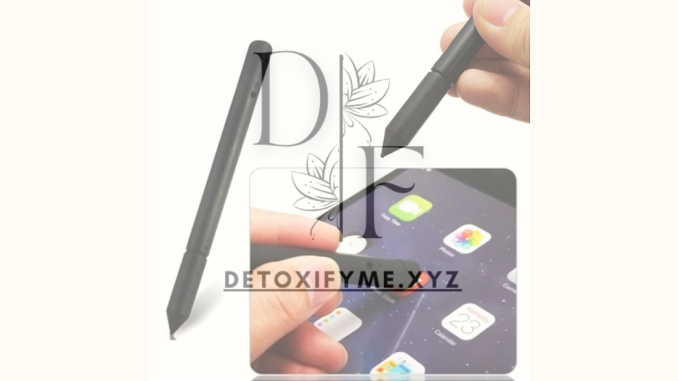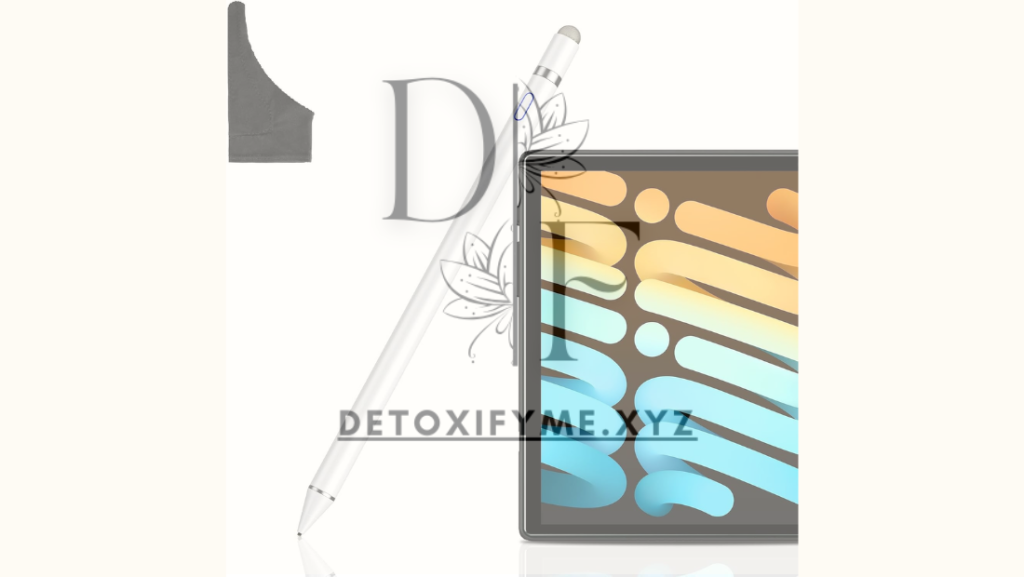
Introduction
With the rise of digital art and mobile note-taking, fine point stylus pens have become essential tools for both artists and students. These pens offer precision, control, and the natural feel of writing or drawing on paper, making them ideal for intricate digital designs and detailed notes. Choosing the right fine point stylus pen can significantly impact your workflow, creativity, and overall experience. This guide will explain the types of fine point styluses, key features to look for, and how to find the perfect stylus for your needs.
1. What is a Fine Point Stylus Pen?
A fine point stylus pen is a digital tool designed to mimic the feel of a traditional pen or pencil. It features a small, precise tip, typically around 1 to 2 millimeters, allowing users to create detailed lines and intricate designs on a touchscreen device. Unlike broader stylus pens used for basic navigation, fine point styluses are favored by digital artists, graphic designers, students, and professionals who need precision in their work.
Benefits of Fine Point Styluses:
- Precision: Ideal for detailed work, from illustrations to handwritten notes.
- Natural Feel: Mimics the experience of using a traditional pen, providing a familiar feel for artists and writers.
- Versatility: Suitable for a variety of tasks, including drawing, designing, and note-taking.
Keywords: fine point stylus pen, digital art stylus, precise stylus pen, touchscreen pen.
2. Types of Fine Point Stylus Pens
Understanding the different types of fine point stylus pens is essential for selecting the right tool. Stylus pens vary in design, functionality, and compatibility with devices. Here are the main types to consider:
Active Stylus
An active stylus is a battery-powered pen that communicates with the touchscreen to create precise lines and strokes. These styluses are typically equipped with features like pressure sensitivity, palm rejection, and tilt recognition. Active styluses are popular among digital artists because they allow for natural shading, line thickness control, and detailed design work.
- Pros: Offers pressure sensitivity and tilt recognition; excellent for digital art.
- Cons: Requires charging or battery replacement; higher price point.
Best For: Artists and designers who need advanced features for professional-level work.
Keywords: active stylus, battery-powered stylus, pressure-sensitive stylus, digital art stylus.

Passive (or Capacitive) Stylus
A passive stylus does not require a battery or Bluetooth connection and functions similarly to a finger on the screen. Although these styluses lack advanced features like pressure sensitivity, they are more affordable and work on any touchscreen device. Passive styluses are commonly used for note-taking and simple sketches but may not provide the fine control needed for detailed artwork.
- Pros: No batteries needed, compatible with most devices, affordable.
- Cons: Lacks advanced features, less precise than active styluses.
Best For: Casual users, students, and anyone looking for an affordable stylus for basic tasks.
Keywords: passive stylus, capacitive stylus, affordable stylus pen, simple touchscreen pen.
Bluetooth Stylus
Bluetooth styluses connect to your device via Bluetooth, enabling additional features like pressure sensitivity, tilt detection, and shortcut buttons. These styluses are particularly useful for artists who need added functionality without sacrificing control and accuracy. However, Bluetooth styluses tend to be more expensive and require periodic charging.
- Pros: Offers advanced features through Bluetooth; customizable functions.
- Cons: Requires charging; typically higher-priced.
Best For: Users who want advanced capabilities like pressure sensitivity and shortcut buttons for enhanced functionality.
Keywords: Bluetooth stylus, advanced stylus pen, customizable stylus, digital drawing pen.
3. Key Features to Consider in a Fine Point Stylus
Choosing the right fine point stylus depends on several important features. Here’s what to look for when selecting a stylus pen for digital art or note-taking:
Pressure Sensitivity
Pressure sensitivity allows the stylus to respond to how hard you press on the screen, adjusting the thickness and darkness of lines. This feature is crucial for artists who want to achieve realistic shading and line variation in their digital artwork.
Why It Matters: Pressure sensitivity gives you more control over line depth and thickness, creating a more natural drawing experience.
Keywords: pressure-sensitive stylus, drawing pen sensitivity, realistic shading stylus.
Palm Rejection
Palm rejection technology allows you to rest your hand on the screen without causing unintended marks or interruptions. This feature is especially useful for artists and note-takers who need to write or draw naturally without worrying about accidental touches.
Why It Matters: Prevents accidental input, ensuring a smooth and natural workflow.
Keywords: palm rejection stylus, touch rejection technology, comfortable drawing experience.
Tilt Recognition
Tilt recognition enables the stylus to detect the angle at which it’s held, allowing for shading effects similar to traditional pencils. This feature is valuable for artists who want more control over shading and depth in their digital illustrations.
Why It Matters: Adds versatility to your drawing, providing a range of effects for professional results.
Keywords: tilt recognition, shading effect stylus, professional drawing tool.
Battery Life
If you’re opting for an active or Bluetooth stylus, battery life is an important consideration. Some styluses offer long-lasting battery life, while others may require frequent charging. Look for options with quick recharge times or replaceable batteries if you use your stylus extensively.
Why It Matters: Long battery life ensures uninterrupted use, especially during extended sessions.
Keywords: stylus battery life, long-lasting stylus, rechargeable stylus pen.
Compatibility
Not all styluses are compatible with every device. Many active and Bluetooth styluses are designed for specific models, like the Apple Pencil for iPads or the Samsung S Pen for Galaxy devices. Make sure the stylus you choose is compatible with your device to avoid connectivity issues.
Why It Matters: Ensures optimal performance and access to all features on your device.
Keywords: device compatibility, iPad stylus pen, Samsung stylus compatibility.
4. Top Stylus Pens for Digital Art and Note-Taking
Here are some of the top fine point styluses currently available, each known for its quality, features, and compatibility.
Apple Pencil (2nd Generation)
The Apple Pencil (2nd Gen) is a premium stylus for iPad users, known for its exceptional pressure sensitivity, tilt recognition, and low latency. Designed for digital artists, the Apple Pencil provides a natural drawing experience with advanced shading and precision. It also charges magnetically by attaching to the iPad, making it convenient and easy to use.
- Best For: iPad users, digital artists, and designers.
- Key Features: Pressure sensitivity, tilt recognition, magnetic charging.
Keywords: Apple Pencil, iPad stylus, premium drawing pen, artist stylus.
Samsung S Pen
The Samsung S Pen is designed for Samsung Galaxy tablets and phones, offering advanced features like pressure sensitivity, palm rejection, and customizable shortcuts. With no need for charging, the S Pen is always ready to use and provides a smooth writing and drawing experience. It’s a versatile stylus that’s well-suited for both professional artists and casual users.
- Best For: Samsung Galaxy device users, artists, and note-takers.
- Key Features: Pressure sensitivity, palm rejection, customizable shortcuts.
Keywords: Samsung S Pen, Galaxy stylus, Android stylus, note-taking stylus.
Adonit Pro 4
The Adonit Pro 4 is a passive stylus with a fine point precision disc, providing accurate control without the need for batteries or Bluetooth. It’s compatible with any touchscreen device, making it an excellent choice for those who need a reliable and affordable stylus. The Adonit Pro 4 is known for its smooth glide and durable build, making it ideal for note-taking and sketching.
- Best For: Note-takers, casual artists, and users with multiple devices.
- Key Features: Fine point disc, universal compatibility, no battery required.
Keywords: Adonit Pro 4, passive stylus, affordable stylus, universal stylus.
5. Tips for Choosing the Right Fine Point Stylus for Your Needs
- Identify Your Primary Use: Determine whether you’ll primarily use the stylus for drawing, writing, or general navigation. Artists may prioritize pressure sensitivity and tilt recognition, while students may need a simple, comfortable stylus for note-taking.
- Consider Your Device Compatibility: Ensure that the stylus is compatible with your device model to access all features, especially if you’re using an active or Bluetooth stylus.
- Evaluate Budget and Features: Set a budget and compare features within that range. High-end styluses offer advanced functionality but may not be necessary for everyone.
Keywords: choose the right stylus, buying tips for stylus, digital drawing pen selection.
Conclusion
A fine point stylus pen can be a valuable tool for digital art, detailed notes, and everyday use, offering a level of precision and control that enhances your experience. From active styluses with pressure sensitivity to versatile passive options, the right stylus can significantly improve your workflow and creativity. By considering your primary needs, device compatibility, and essential features, you can find the perfect fine point stylus that supports your digital pursuits, whether you’re creating art or organizing your notes.
Leave a Reply